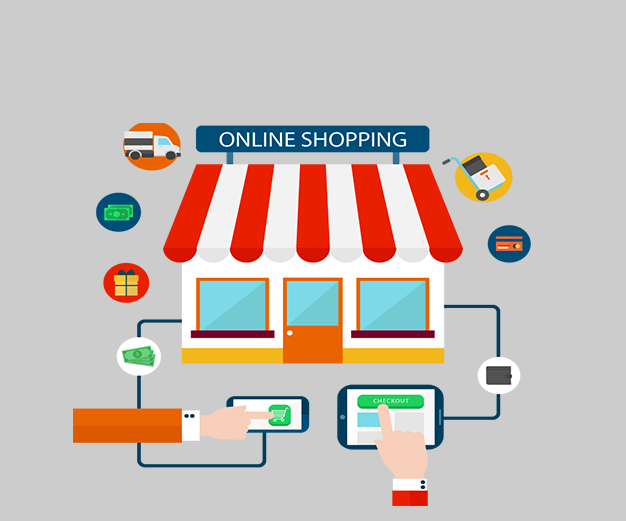Introduction to E-commerce website: A Thriving Digital Landscape
The Evolution of E-commerce:

E-commerce, short for electronic commerce, has undergone a remarkable transformation since its inception. From humble beginnings in the late 1990s with basic online stores, it has evolved into a powerful force shaping the modern business landscape. Here’s a glimpse into its fascinating journey:
- Early Days (1990s): The emergence of the internet paved the way for online marketplaces like eBay, offering auction-based transactions between individuals. This marked the initial steps towards a digitalized shopping experience.
- Growth and Diversification (2000s): The rise of e-commerce giants like Amazon and the development of secure online payment gateways like PayPal fueled rapid growth in the sector. Businesses began establishing their own online stores, offering a wider variety of products and fostering direct-to-consumer (D2C) sales models.
- Mobile Revolution (2010s): The widespread adoption of smartphones and tablets ushered in a new era of mobile commerce (m-commerce). Consumers embraced the convenience of shopping on the go, further propelling the growth of e-commerce.
- The Future of E-commerce (Present and Beyond): Emerging technologies like artificial intelligence (AI), virtual reality (VR), and voice search are expected to further revolutionize the e-commerce experience. Personalized recommendations, immersive product visualizations, and seamless voice-activated shopping are just a few examples of what the future holds.
Importance of E-commerce in the Modern Business Landscape:

E-commerce has become an integral part of the modern business landscape for several key reasons:
- Digital Economy: The internet has fostered the growth of the digital economy, creating a global marketplace where businesses can reach customers beyond geographical limitations. This expands market reach and allows businesses of all sizes to compete on a larger scale.
- Market Expansion: E-commerce enables businesses to tap into new markets that may not have been accessible through traditional brick-and-mortar stores. This allows them to cater to a wider customer base and explore new growth opportunities.
- Consumer Convenience: E-commerce offers unmatched convenience to consumers. The ability to browse, compare, and purchase products from the comfort of their homes, 24/7, has drastically changed consumer behavior and expectations.
- Reduced Costs: E-commerce can be more cost-effective for businesses compared to traditional retail models. Lower overhead costs associated with physical stores translate to potentially competitive pricing and improved profit margins.
- Data-Driven Insights: E-commerce platforms generate valuable customer data on purchasing behavior and preferences. Businesses can leverage this data to personalize marketing strategies, optimize product offerings, and improve the overall customer experience.
Key Components of a Successful E-commerce Business:

Building a thriving e-commerce business requires careful consideration of various factors:
- Website Design: A user-friendly and visually appealing website is critical. It should be easy to navigate, feature high-quality product images and descriptions, and ensure a seamless checkout process.
- User Experience (UX): Prioritize creating a positive user experience (UX). This includes offering fast loading times, secure payment options, clear product information, and excellent customer service.
- Payment Integration: Integrate secure and reliable payment gateways to accept online payments from customers. Popular options include PayPal, Stripe, and credit card processors.
- Marketing and Customer Acquisition: Implement effective marketing strategies to attract and convert potential customers. Utilize channels like search engine optimization (SEO), social media marketing, and email marketing to reach your target audience.
- Logistics and Fulfillment: Establish efficient logistics and fulfillment processes to ensure timely and reliable product delivery to customers. This includes partnering with reliable shipping carriers and offering various delivery options.
By understanding the evolution, importance, and key components of e-commerce, businesses can leverage its tremendous potential to reach new consumers, expand their market reach, and thrive in the ever-evolving digital landscape.
Building a Robust E-commerce Website: Laying the Foundation for Success
In today’s digital world, having a robust e-commerce website is essential for any business venturing into the online marketplace. This chapter delves into the crucial steps involved in building such a website, focusing on platform selection, mobile optimization, and transaction security.
Choosing the Right E-commerce Platform:
Selecting the right e-commerce platform is the foundation upon which your online store is built. It plays a significant role in determining the functionality, scalability, and overall effectiveness of your website. Here are some key factors to consider when choosing an e-commerce platform:
- Ease of Use: Evaluate the user-friendliness of the platform for both you and your customers. Opt for a platform with an intuitive interface that allows you to easily manage your products, orders, and website content without requiring extensive technical expertise.
- Scalability: Choose a platform that can accommodate your business growth as your product offerings and customer base expand. Consider the platform’s ability to handle increasing traffic volumes and potentially integrate with additional functionalities in the future.
- Customization and Features: Assess the customization options offered by the platform. Look for a platform that allows you to personalize the look and feel of your website to match your brand identity and offer features that are essential for your business model, such as product reviews, discount codes, or advanced inventory management tools.
- Cost: Compare the pricing models of different platforms, considering both monthly subscription fees and transaction fees. Choose a platform that aligns with your budget and business needs.
Popular E-commerce Platforms:
- Shopify: Ideal for beginners and small businesses due to its user-friendly interface and wide range of integrations.
- WooCommerce: An open-source platform built on WordPress, offering greater customization flexibility and scalability for businesses with technical expertise.
- Magento: A powerful and scalable platform suitable for larger businesses requiring advanced features and functionalities.
Choosing the right platform requires careful evaluation of your specific needs and resources. Consider conducting thorough research, exploring free trials, and consulting with e-commerce experts to make an informed decision.
Responsive Design and Mobile Optimization:
In today’s mobile-first world, ensuring your website offers a flawless experience across all devices is crucial. Mobile optimization is no longer an option, but a necessity. Here’s why:
- Mobile Dominance: Over half of all online traffic now originates from mobile devices. If your website is not mobile-friendly, users are likely to abandon it, leading to lost sales and decreased engagement.
- Search Engine Ranking: Mobile-friendliness is a ranking factor for search engines. A website that is not optimized for mobile devices may rank lower in search results, hindering its visibility and organic traffic potential.
- Enhanced User Experience: A responsive website adapts seamlessly to different screen sizes, ensuring easy navigation, clear product information, and a smooth checkout process on any device. This translates to a positive user experience and increased customer satisfaction.
Key Elements of Responsive Design:
- Fluid Layouts: Utilizes flexible layouts that adjust automatically to fit various screen sizes.
- High-Resolution Images: Employs images that scale effectively and retain quality on all devices.
- Touch-Friendly Interface: Ensures buttons, forms, and menus are large enough and easy to tap with fingers.
By implementing responsive design best practices, you can create a mobile-friendly website that caters to the needs of modern online consumers and fosters a positive experience across all devices.
Securing E-commerce Transactions:
Building trust with customers is crucial for any e-commerce business. Implementing robust security measures to protect customer data and ensure secure transactions is paramount. Here are some key steps to consider:
- SSL Certificates: Secure Sockets Layer (SSL) certificates encrypt the communication between your website and your customers’ browsers. This ensures that sensitive information, such as credit card details and personal information, is transmitted securely and cannot be intercepted by unauthorized individuals. Look for the padlock icon and “https” in the address bar to verify that a website has a valid SSL certificate.
- Payment Security: Choose a reliable and secure payment gateway to process online transactions. Popular options include PayPal, Stripe, and major credit card processors. These platforms offer advanced security features and comply with industry-standard security protocols to protect sensitive financial information.
- Fraud Prevention: Implement fraud prevention measures to minimize the risk of fraudulent transactions. These measures can include:
- Address verification: Verify the billing and shipping addresses provided by customers against established databases.
- CVV code verification: Require customers to enter the Card Verification Value (CVV) code from their credit card during checkout.
- Fraud scoring: Utilize fraud scoring models that analyze various factors associated with transactions to identify potential fraudulent activity.
- Data Security: Implement data security best practices to protect customer information stored on your website. This includes:
- Regular data backups: Regularly back up your website data to ensure you can recover information in case of emergencies.
- Strong password policies: Enforce strong password policies for both customer accounts and administrative access to your website.
- Regular system updates: Keep your website software and plugins updated to address any known security vulnerabilities.
Content Marketing and SEO Strategies:
- Building a successful e-commerce website goes beyond just having a functional platform and secure transactions. Content marketing and search engine optimization (SEO) play crucial roles in driving organic traffic and attracting potential customers.
- Content Marketing: Create high-quality and informative content that is relevant to your target audience and product offerings. This can include blog posts, product descriptions, customer testimonials, and informative guides.
- SEO Optimization: Optimize your website content and product listings with relevant keywords that potential customers are likely to use when searching for products online. Utilize on-page SEO techniques like meta descriptions, title tags, and internal linking to improve your website’s search engine ranking.
Customer Service and Support:
Providing excellent customer service and support is essential for building trust and fostering customer loyalty. Here are some key aspects to consider:
- Multiple Communication Channels: Offer customers various communication channels to reach your support team, such as email, phone, and live chat.
- Prompt and Efficient Response: Ensure prompt and efficient responses to customer inquiries and concerns.
- Returns and Refund Policy: Have a clear and transparent returns and refund policy in place to address customer concerns and build trust.
By carefully selecting an e-commerce platform, optimizing for mobile devices, implementing robust security measures, and employing effective content marketing and customer service strategies, you can build a robust e-commerce website that lays the foundation for success in the competitive online marketplace. Remember, an e-commerce website is a dynamic entity that requires ongoing maintenance, updates, and adaptation to evolving trends and customer expectations. By staying committed to delivering a positive user experience, secure environment, and valuable content, you can attract customers, foster brand loyalty, and drive the growth of your e-commerce business.
E-commerce Marketing Strategies: Reaching and Engaging Your Audience
In today’s digital landscape, simply having a well-designed e-commerce website isn’t enough. To thrive in the competitive online marketplace, you need effective marketing strategies to reach your target audience, drive traffic to your website, and ultimately convert visitors into customers. This chapter explores three key e-commerce marketing strategies: Search Engine Optimization (SEO), Social Media Integration & Influencer Marketing, and Email Marketing Campaigns.
Search Engine Optimization (SEO) for E-commerce:
SEO plays a crucial role in enhancing the visibility of your e-commerce website in search engine results pages (SERPs). When potential customers search for products online, you want your website to appear at the top of the search results, leading them directly to your store. Here are some SEO best practices for e-commerce:
- Keyword Optimization: Conduct keyword research to identify relevant keywords that your target audience is likely to use when searching for products.
- Optimize Product Descriptions: Include relevant keywords naturally within your product descriptions, ensuring they are informative and engaging for users.
- On-Page Optimization: Implement on-page optimization techniques such as using meta descriptions, title tags, and internal linking to improve your website’s ranking.
- Technical SEO: Ensure your website has a clean and well-structured code, with fast loading times and mobile-friendliness, which are also considered by search engines when ranking websites.
Social Media Integration and Influencer Marketing:
Social media platforms offer a powerful avenue to connect with your target audience, build brand awareness, and drive traffic to your website. Here are a few ways to leverage social media for your e-commerce business:
- Social Commerce: Utilize social commerce features offered by platforms like Instagram and Facebook to showcase products, run targeted ads, and enable seamless purchasing directly within the social media platform.
- Influencer Collaboration: Partner with relevant influencers in your niche to promote your products to their audience. Choose influencers whose values and target audience align with your brand.
- Engaging Content Strategy: Create engaging and visually appealing content on your social media platforms, such as product photos, user-generated content, and behind-the-scenes glimpses into your brand.
Email Marketing Campaigns for E-commerce:
Email marketing remains a highly effective tool for engaging with customers, promoting new products, and driving sales. By building an email list and developing targeted email campaigns, you can nurture leads, convert potential customers, and foster brand loyalty. Here are some key aspects of successful ecommerce email marketing:
- Email Automation: Utilize email automation tools to send personalized emails based on customer behavior and interests. This can include welcome emails, abandoned cart reminders, and post-purchase follow-ups.
- Segmentation: Segment your email list by demographics, interests, or purchase history to deliver targeted messages that resonate with different audience segments.
- Offer Value and Incentives: Include valuable content, exclusive offers, and relevant promotions in your emails to incentivize engagement and encourage purchases.
By implementing these three key marketing strategies, you can reach your target audience, increase brand awareness, drive traffic to your website, and ultimately convert visitors into loyal customers. Remember, consistency and experimentation are key to success in e-commerce marketing. Continuously monitor your results, adapt your strategies based on data and insights, and strive to deliver a personalized and engaging experience for your customers across all touchpoints.
E-commerce Inventory Management: Keeping Your Virtual Shelves Stocked
In the fast-paced world of e-commerce, efficient inventory management is crucial for ensuring customer satisfaction, maintaining a positive brand image, and avoiding lost sales. This chapter explores key aspects of effective e-commerce inventory management, focusing on product organization, inventory tracking systems, and handling product returns and refunds.
Efficient Product Listing and Categorization:
A well-organized and user-friendly product listing is essential for enhancing the customer experience and facilitating efficient order fulfillment. Here are some key aspects to consider:
- Product Organization: Categorize products logically and intuitively, making it easy for customers to find what they are looking for. Consider using subcategories and filters to further refine the search experience.
- Detailed and Accurate Descriptions: Provide comprehensive and informative product descriptions that include key details such as size, color, material, and functionalities.
- High-Quality Images: Use high-resolution and clear product images from various angles to showcase the products accurately and entice potential buyers.
- Product Tags: Utilize relevant keywords as product tags to improve search functionality and ensure customers can easily discover your products.
Implementing Inventory Tracking Systems:
Maintaining accurate and up-to-date inventory records is essential for preventing stockouts, overstocking, and fulfillment errors. Here are some key strategies to consider:
- Inventory Software: Utilize inventory management software to track product stock levels, manage purchase orders, and set up reorder points to ensure timely product replenishment.
- Real-Time Updates: Implement real-time inventory updates to reflect changes in stock levels as soon as they occur. This helps avoid overselling products that are out of stock and prevents customer frustration.
- Regular Inventory Audits: Conduct regular inventory audits to reconcile physical stock with software records and identify any discrepancies.
Dealing with Product Returns and Refunds:
Having a clear and customer-friendly return and refund policy builds trust and fosters positive customer experiences. Here are some key considerations:
- Return Policy: Clearly outline the conditions, timeframe, and process for returning products on your website.
- Customer Satisfaction: Prioritize customer satisfaction by offering flexible return options whenever possible.
- Refund Processes: Establish streamlined and efficient refund processes to ensure prompt resolution of return requests and maintain customer satisfaction.
By implementing these inventory management strategies, you can ensure that your virtual shelves are always well-stocked, your customers have a positive and seamless shopping experience, and your e-commerce business operates efficiently and profitably.
Customer Experience: The Heart of E-commerce Success
In the competitive world of e-commerce, prioritizing customer experience (CX) is no longer optional, it’s essential. A positive CX can significantly impact customer satisfaction, brand loyalty, and ultimately, your business’s bottom line. This chapter explores three key aspects of building a customer-centric e-commerce experience:
User-Friendly Interface and Navigation:
- User Experience (UX) Design: Invest in a user-friendly website design with intuitive navigation, clear product information, and a seamless checkout process.
- Mobile Optimization: Ensure your website is optimized for mobile devices, allowing for smooth browsing and purchasing experiences on the go.
- Fast Loading Times: Prioritize fast loading times to avoid frustrating users and potentially losing sales.
Personalization in E-commerce:
- Personalized Recommendations: Utilize customer data to offer personalized product recommendations, showcasing items relevant to their past purchases and browsing behavior.
- Customer Profiles: Allow customers to create user profiles to save preferences, track order history, and receive personalized communication.
- Targeted Marketing Campaigns: Implement targeted marketing campaigns based on customer segments and preferences, delivering relevant content and promotions.
Customer Support and Communication:
- Multiple Support Channels: Offer multiple communication channels for customer support, such as email, phone, and live chat, to cater to different preferences.
- Responsive Support: Provide prompt and responsive customer support to address inquiries and concerns efficiently.
- Transparency and Clear Communication: Maintain transparency and clear communication throughout the customer journey, from product information to order updates and return policies.
By focusing on these key elements of customer experience, you can create a customer-centric e-commerce environment that fosters loyalty, trust, and ultimately, the success of your online business. Remember, listening to customer feedback, addressing concerns promptly, and exceeding expectations are essential for building a thriving e-commerce brand.
Ensuring E-commerce Security
Cybersecurity Measures for E-commerce:
In today’s digital world, cybersecurity threats are a constant concern for e-commerce businesses. Protecting sensitive customer data, such as payment information and personal details, is paramount. Here are some essential cybersecurity measures:
- SSL Encryption: Implement Secure Sockets Layer (SSL) certificates to encrypt communication between your website and customer browsers, safeguarding data transmission.
- Regular Security Updates: Maintain updated software on your website and servers to address potential vulnerabilities exploited by attackers.
- Data Breach Prevention: Implement strong access controls, intrusion detection systems, and data backup practices to minimize the risk of data breaches and ensure rapid recovery in case of incidents.
Legal and Regulatory Compliance in E-commerce
Compliance with Data Protection Laws:
Operating an e-commerce business requires adherence to various legal and regulatory requirements, particularly concerning data protection. Here are some key points to consider:
- GDPR Compliance: The General Data Protection Regulation (GDPR) in Europe and similar regulations in other jurisdictions impose strict requirements for how businesses collect, store, and use customer data.
- Privacy Policies: Clearly outline your privacy policy on your website, informing customers about how you collect, use, and protect their data.
- Data Handling: Implement secure data handling practices, obtain user consent for data collection, and offer clear options for users to access, modify, or delete their personal information.
By prioritizing security and adhering to legal regulations, you can build trust with your customers, mitigate potential risks, and ensure the sustainable growth of your e-commerce business. Remember, staying informed about evolving regulations and best practices is essential for navigating the legal landscape of e-commerce.
E-commerce Trends and Future Outlook
The e-commerce landscape is constantly evolving, and staying ahead of the curve is crucial for businesses to thrive. Here’s a glimpse into some key trends shaping the future of e-commerce:
Emerging Technologies in E-commerce:
- Augmented Reality (AR) and Virtual Reality (VR): These technologies offer immersive product experiences, allowing customers to virtually “try on” clothes, visualize furniture in their homes, or explore products in 3D environments.
- Blockchain: This technology has the potential to revolutionize supply chain management, offering greater transparency and traceability for products, and potentially enhancing customer trust.
Sustainable and Ethical E-commerce Practices:
- Eco-Friendly Packaging: Consumers are increasingly environmentally conscious, and businesses are adopting sustainable packaging practices to minimize environmental impact.
- Ethical Sourcing: Businesses are facing growing pressure to source products ethically, considering factors like fair labor practices and environmental responsibility throughout the supply chain.
- Corporate Responsibility: E-commerce businesses are expected to demonstrate social and environmental responsibility beyond just products and services, aligning with consumer values.
E-commerce and the Rise of Voice Search:
- Voice Commerce: With the growing popularity of voice-activated devices, e-commerce businesses need to optimize their websites and product listings for voice search to ensure discoverability and cater to this evolving customer behavior.
- Conversational Commerce: This trend involves using chatbots and other interactive tools for personalized communication with customers, offering a more conversational and engaging shopping experience.
By embracing these emerging trends and adapting to evolving consumer expectations, e-commerce businesses can position themselves for continued success in the ever-changing digital landscape.
Conclusion: Mastering Ecommerce Excellence
The e-commerce landscape presents a dynamic and exciting opportunity for businesses of all sizes. By strategically navigating its various facets, you can build a thriving online presence and achieve success. This comprehensive guide has explored the essential components of e-commerce, from choosing the right platform to securing transactions, crafting compelling content, and fostering a positive customer experience.
Remember, e-commerce excellence is a journey, not a destination. Staying informed about emerging trends, adapting to evolving customer expectations, and continually refining your strategies are essential for maintaining a competitive edge. By prioritizing security, legal compliance, ethical practices, and continuous improvement, you can build trust with your customers and position your e-commerce business for long-term success in the ever-evolving digital landscape. Embrace the opportunities e-commerce offers and unlock the potential for your business to thrive in the exciting world of online commerce.








